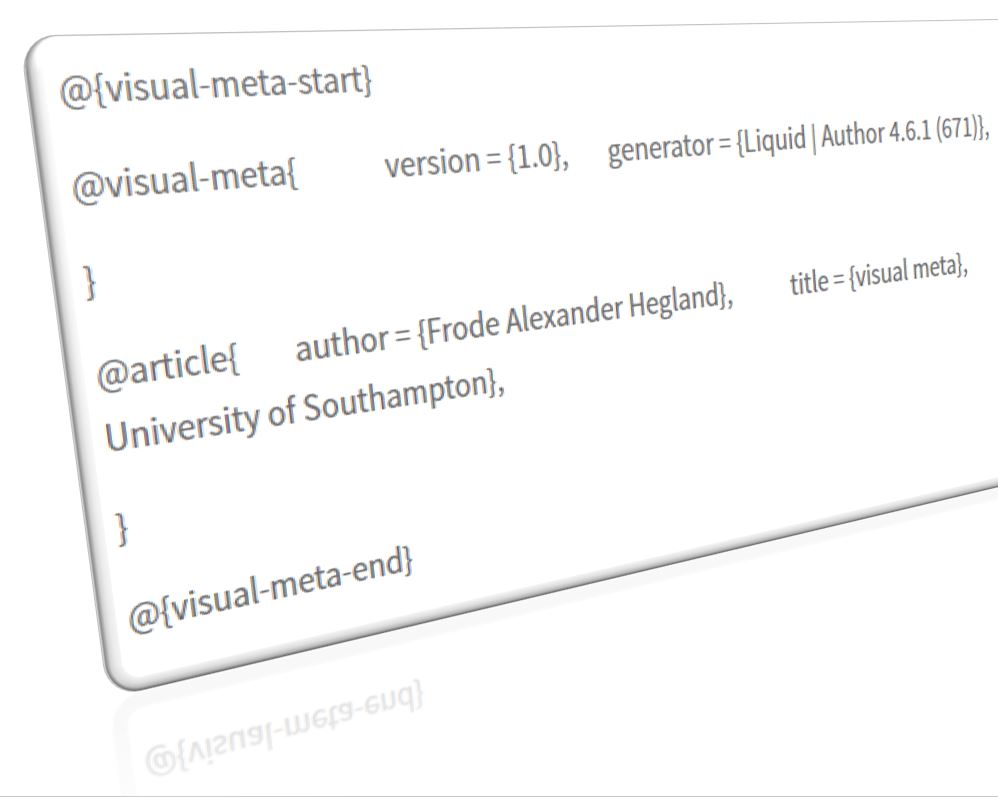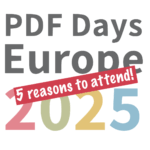A Visual-Meta Approach

Frode Hegland is currently a PhD student at the University of Southampton under Wendy Hall and Les Carr. He is the originator of the Visual-Meta approach for document metadata for PDF and other documents. Frode Hegland is currently curating the largest collection of perspectives on the future of text ever … Read more


The Visual-Meta approach take the metadata out of of the document internals and presents it as an appendix at the end of the document, allowing the reader software to parse the content of the document and to provide interactions such as allow the user to select and copy any text and paste as citation in one operation.
Advanced Interactions Enabled Include
- Copy As Citation - using a simple copy command, with all citation information added to the clipboard payload for use by Visual-Meta aware applications on Paste
- Formatting Automation – Instead of the author conforming to one specific academic requirement, formatting can be applied on the reading system based on the Visual-Meta context, separating content from presentation
- Instant Outline & Advanced Layouts - based on the document specifying heading formatting and spatial layouts, allowing for spatial hypertext support
- Retained Data – tables and other embedded data can be explicitly made available
- Server Access - repositories can extract information for large-scale analysis
- Glossary Support - glossary terms can be added to the appendix
- High Resolution, Document Based Addressing - the Name of the document is not the same as the Title and this can be be used to address by document and not location and support High-Resolution Addressing, as described at wordpress.liquid.info/addressability-supplemental-augmentation-for-visual-meta/
EXAMPLE
@{visual-meta-start}
@visual-meta{
version = {1.0},
generator = {Liquid | Author 4.6.1 (671)}, }
@article{
author = {Frode Alexander Hegland},
title = {visual meta},
month = jul,
year = {2019},
institution = { University of Southampton}, }
@formating{
level1head = {18 point Helvetica},
level2head = {14 point Helvetica},
level3head = {10 point Helvetica},
imagecaptions = {Times, 10, italic, align center}, }
@glossary{
term = {Name of glossary term}, definition = {freeform definition text}, relates to = {relationship – “other term”}, }
@{visual-meta-end}
BENEFITS
For an author this approach means they can embed more rich information in their document with minimum effort and be sure of the robustness of the information over time.
It allows the reader a much faster way to cite with a higher degree of accuracy and more access to the original data and interactions.
Augmented textual communication. Using the appendices to describe the document content, such as the formatting of headings and citations as well as the use of glossaries, can allow the reading software to present the document to the reader’s preference without loosing the creator’s semantics.
Server Friendly which allows for large scale citation and other document element analysis. The University of Southampton’s Christopher Gutteridge, one the of the people behind the university repository, elaborates on this: jrnl.global/2019/07/01/ideas-for-rich-documents/
Institutions can worry less about the cosmetics of citations and benefit from more documents cited being checked and read. This could put an end to the absurd academic time-wasting of nit-picking the way citations should be displayed: Let the teacher/examiner/reader specify how the citations should be displayed, based on the document having described in the appendix how they are used and therefore the reader can re-format the the readers tastes. Universities still get to dictate the default handing-in formatting but the same document could be displayed in any format the reader chooses.
ADOPTION SUPPORT
Compatibility with legacy readers is maintained since they will only see the metadata as plain text. When using a supported Reader, the user can download a PDF and copy the BibTeX export format on the download page, then open the PDF in Reader and click to ‘Assign BibTeX’ and it will be applied as an appendix and saved, same as if it was natively exported with Visual-Meta. Only the citation information will be provided in this way – formatting, etc. will not be available. Reader applications can also send non-visual-meta PDFs to a server, such as Scholarcy to have the Visible-Meta extracted and appended.
PROOF OF CONCEPT
There are applications using this available in the macOS App Store as proof of concept and for testing. Links can be provided on request.




